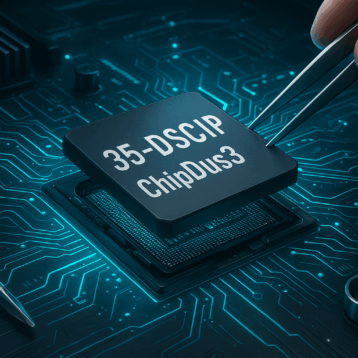|
In the future, sensors may be implanted in our bodies to measure blood-glucose levels of diabetics or retinal pressure in glaucoma patients. In practical terms, the chips would have to both be very small and use long-lasting batteries of a similar small size; however this combination is not commercially accessible today.
Phoenix measures one square millimetre. The major accomplishment is that the Phoenix is the same size as its thin-film battery. Current chips are one square millimetre and smaller, but require a significantly larger battery because of their power consumption.
In most cases, batteries are much larger than the processors they power, severely increasing the size and cost of the entire system, said David Blaauw, a professor in the Department of Electrical Engineering and Computer Science in the University of Michigan. For example, the battery in a laptop computer is roughly 5,000 times larger than the processor and it offers only a few hours of power.
|
The Phoenix chip consumes just 30 picowatts during sleep mode. A picowatt is one-trillionth of a watt. In theory, the energy used for a watch battery is equivalent to operate the Phoenix for 263 years. “Low power consumption allows us to reduce battery size and thereby overall system size. Our system, including the battery, is projected to be 1,000 times smaller than the smallest known sensing system today,” Blaauw said. “It could allow for a host of new sensor applications.”
A group of University of Michigan researchers is integrating the Phoenix into biomedical sensors to monitor eye pressure in glaucoma patients. Engineers imagine that chips like these could also be spread around to create an almost undetectable sensor network to monitor air and water or detect movement. It could be incorporated into concrete to sense the structural integrity of new buildings and bridges. It could also power a robust pacemaker that could obtain more comprehensive readings of a patient’s health.
To attain such low power, Phoenix engineers focused on sleep mode, where sensors can spend more than 99 percent of their lives. Sensors operate momentarily to handle computation at frequent intervals. When the system defaults to sleep a low-power timer works as an alarm clock on perpetual snooze activating Phoenix every ten minutes for 1/10th of a second to run a set of 2,000 instructions.
The list is comprised of examining the sensor for new data, processing it, compressing it into short-hand, and storing it before going back to sleep. The timer is not an atomic clock, but is keeps time to 10 minutes plus or minus a few tenths of a second. A unique power gate design is a key component of the sleep process. Power gates impede the electric current from certain sections of a chip not crucial for memory during sleep.
In normal state-of-the-art chips, power gates are wide with low resistance to allow as much electric current to flow when the device is switched on. These chips wake up promptly and process rapidly, but a considerable amount of electric current leaks during sleep mode.
To overcome this performance issue, the Michigan team amplified the chip’s operating voltage, boosting the baseline power by nearly 20 percent when the chip is in operation. However Phoenix still functions at 0.5 Volts, compared to the 1 to 1.2 Volts that are required by conventional chips.
TFOT has previously written about the MIT team who developed an energy efficient microchip that significantly decreases microchip energy consumption to one tenth of the current rates. You can also check out our article about ultra small switches measuring about one tenth the size of a human hair, which may eventually be used in small consumer devices. This technology may provide homes and offices with an optical fiber connection that would allow high speed delivery of data such as music files, games, and videos.
Additional information on the Phoenix Processor can be obtained at University of Michigan’s website.









![How to Reset Insignia TV [Step-By-Step Guide]](https://thefutureofthings.com/wp-content/uploads/2025/01/Insignia-Roku-TV-358x358.png)


